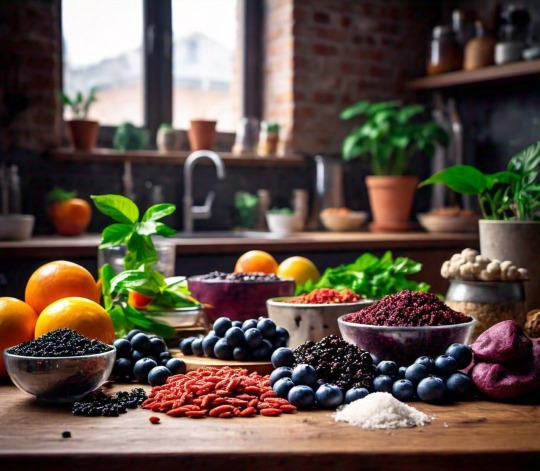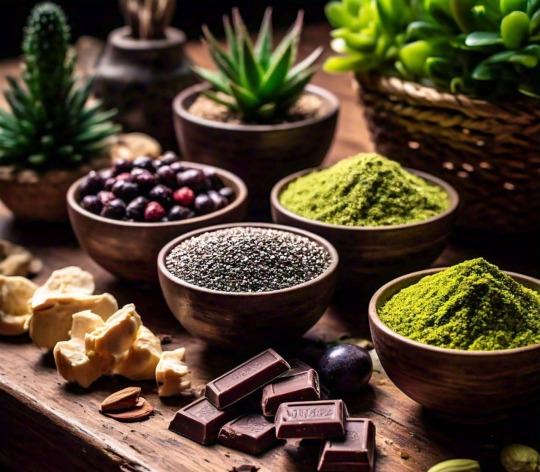Don't wanna be here? Send us removal request.
Text
The Power of Kale: Why This Superfood Deserves a Spot on Your Plate
In the world of healthy eating, few foods have garnered as much attention as kale. This leafy green vegetable has become a staple in smoothies, salads, and even snacks, and for good reason. Packed with nutrients, low in calories, and incredibly versatile, kale is a true superfood that can benefit your health in countless ways. If you haven’t already embraced this vibrant green, here’s why you should.

What Makes Kale So Special?
Kale belongs to the cruciferous vegetable family, which includes other nutritional powerhouses like broccoli, cauliflower, and Brussels sprouts. What sets kale apart is its impressive nutrient profile. Just one cup of raw kale contains:
Vitamin K: Essential for blood clotting and bone health.
Vitamin A: Important for vision and immune function.
Vitamin C: A powerful antioxidant that supports skin health and immunity.
Calcium: Crucial for bone health (yes, kale has more calcium per calorie than milk!).
Fiber: Promotes digestive health and keeps you feeling full.
Antioxidants: Helps combat oxidative stress and inflammation in the body.
And the best part? Kale is incredibly low in calories, making it a perfect addition to any diet.

Health Benefits of Kale
Supports Heart Health Kale is rich in fiber, potassium, and antioxidants, all of which contribute to a healthy heart. The fiber helps lower cholesterol levels, while potassium regulates blood pressure. Additionally, the antioxidants in kale, such as quercetin and kaempferol, have anti-inflammatory properties that protect against heart disease.
Boosts Immunity With its high vitamin C content, kale is a natural immune booster. Vitamin C stimulates the production of white blood cells, which are essential for fighting off infections. Plus, the antioxidants in kale help reduce inflammation, keeping your immune system strong.
Promotes Healthy Skin and Hair The vitamins A and C in kale play a key role in maintaining healthy skin and hair. Vitamin A helps with cell growth and repair, while vitamin C is necessary for collagen production, which keeps your skin firm and your hair strong.
Aids in Digestion Kale is an excellent source of fiber, which supports a healthy digestive system. Fiber helps regulate bowel movements, prevents constipation, and feeds the beneficial bacteria in your gut.
Supports Bone Health Thanks to its high levels of vitamin K and calcium, kale is a great food for maintaining strong bones. Vitamin K helps your body absorb calcium, reducing the risk of osteoporosis.
How to Incorporate Kale into Your Diet
One of the best things about kale is its versatility. Here are some easy and delicious ways to enjoy this superfood:
Kale Smoothies Add a handful of kale to your morning smoothie. Pair it with fruits like bananas, apples, or berries to balance out the slightly bitter taste.
Kale Salads Massage kale with a bit of olive oil and lemon juice to soften the leaves, then toss it with your favorite toppings like nuts, seeds, and a light vinaigrette.
Kale Chips Bake kale leaves with a drizzle of olive oil and a sprinkle of salt for a crunchy, healthy snack.
Sautéed Kale Sauté kale with garlic, olive oil, and a pinch of red pepper flakes for a quick and nutritious side dish.
Kale in Soups and Stews Add chopped kale to soups, stews, or pasta dishes for an extra boost of nutrients.
A Word of Caution
While kale is incredibly healthy, it’s important to enjoy it in moderation. Kale is high in vitamin K, which can interfere with blood-thinning medications. Additionally, consuming large amounts of raw kale may affect thyroid function due to its goitrogen content. Cooking kale can help reduce this effect.
Conclusion
Kale is more than just a trendy health food—it’s a nutrient-dense powerhouse that can transform your diet and improve your overall health. Whether you’re blending it into a smoothie, baking it into chips, or tossing it into a salad, there are countless ways to enjoy this leafy green. So, the next time you’re at the grocery store, grab a bunch of kale and start reaping the benefits of this incredible superfood. Your body will thank you!
0 notes
Text
Supercharge Your Health!
Discover the power of superfoods!

Packed with nutrients, antioxidants and fiber, these mighty foods boost energy, support immunity and promote overall wellness.
Top Superfoods :
Kale : Rich in vitamins A, C and K.
Blueberries : Antioxidant-rich brain food.
Salmon : Omega-3 fatty acid powerhouse.
Spinach : Iron and calcium superstar.
Acai berries : Antioxidant-rich heart health.
Incorporate these superfoods into your daily diet for a healthier, happier you!
0 notes
Text
The Truth About Superfoods: Are They Really That "Super"?
The concept of superfoods has gained tremendous popularity in recent years. Magazines, blogs, and social media posts consistently praise foods like berries, quinoa, and salmon for their extraordinary health benefits. However, behind the marketing and hype, what do we truly know about these so-called superfoods? Are they magical dietary components capable of transforming our health, or is there more to the story?

What Are Superfoods?
Superfoods are nutrient-dense foods, often packed with antioxidants, vitamins, minerals, and other beneficial compounds. These foods tend to be fruits, vegetables, and other plant-based items that boast a wide range of health benefits. You’ve probably heard about green tea, dark chocolate, chia seeds, and acai berries being labeled as superfoods. The “super” label often suggests that consuming these foods can lead to enhanced health, longevity, and even disease prevention.
However, superfoods are not magic bullets. They won’t cure diseases or make you live longer simply by being a part of your diet. Instead, they should be considered as part of a balanced, varied diet that emphasizes whole, minimally processed foods.

The Hype vs. Reality: Superfoods Are Not Medicine
While these foods have excellent nutritional profiles, they are often marketed as more than they really are. The problem with the “super” label is that it implies an ability to cure or prevent diseases, which isn’t scientifically supported in most cases.
For example, while blueberries are rich in antioxidants and can help fight oxidative stress, they are not a substitute for medication or a treatment for chronic diseases. Similarly, green tea may have positive effects on heart health, but it is not a cure-all beverage. The beneficial compounds in these foods contribute to better health when consumed regularly as part of a diverse diet, but they cannot replace a balanced lifestyle that includes other critical elements like regular physical activity and stress management.
The Good News: Superfoods Are Still Good For You
Despite the marketing exaggerations, it’s important to emphasize that superfoods do have significant health benefits. The foods commonly labeled as superfoods are typically rich in essential nutrients, low in unhealthy fats, and can offer a variety of health-promoting compounds.
Adding superfoods to your diet—like sprouted beans, goji berries, or seaweed—will increase the diversity of your meals and improve your intake of vitamins, minerals, and antioxidants. For example, berries are high in vitamin C and fiber, while quinoa is a fantastic source of plant-based protein and essential amino acids. However, they should complement, not dominate, your dietary pattern.
Think of superfoods as helpful dietary tools that can boost your overall nutritional intake. When paired with other whole foods—such as legumes, grains, nuts, vegetables, and lean proteins—they contribute to a well-rounded, healthy diet.

Flavonoids: A Closer Look
Flavonoids—a group of polyphenolic compounds found in many superfoods. Flavonoids are known for their antioxidant properties and have been linked to various health benefits, particularly regarding cardiovascular health.
Flavonoids can help reduce inflammation, lower blood pressure, and fight oxidative stress, which can lead to a decreased risk of chronic conditions like heart disease. Foods rich in flavonoids include dark chocolate, berries, tea, and citrus fruits.
However, more research is needed to fully understand how flavonoids interact with our bodies over the long term. While early studies are promising, it’s essential to be cautious when attributing specific medicinal qualities to foods based on flavonoid content alone. Instead, aim to consume a variety of foods rich in flavonoids to promote overall health.
Antinutrients: The Dark Side of Superfoods?
While superfoods are often celebrated for their beneficial compounds, some also contain antinutrients—substances that can interfere with nutrient absorption. For example, phytic acid, found in grains and legumes, can bind to minerals like calcium and zinc, reducing their absorption in the body. Similarly, tannins—present in foods like tea and certain fruits—can inhibit iron absorption.
While the presence of antinutrients in foods might sound alarming, they are generally not a concern for most people who consume a balanced diet. In fact, in moderate amounts, some antinutrients may have health benefits. Phytic acid, for instance, may reduce blood glucose levels and improve heart health. Moreover, simple preparation techniques like soaking, boiling, and fermenting can significantly reduce the levels of antinutrients in food.
Superfoods and Gluten-Free Diets
Gluten-free diets have become increasingly popular, often being linked to the consumption of certain superfoods like quinoa and buckwheat. While these foods are excellent alternatives for those with celiac disease or gluten sensitivity, it’s essential to remember that a gluten-free diet isn’t automatically healthier for everyone. Gluten-containing foods like whole grains are rich in fiber, B-vitamins, and other essential nutrients that contribute to good health.
For those who don’t have a medical reason to avoid gluten, there’s no need to swap out all gluten-containing foods for superfood alternatives. Focus instead on balance and moderation.
Tools for Making Informed Food Choices
we will introduce some tools and concepts that go beyond superfoods and can help you make more informed food choices:
Longitudinal Dietary Assessments (LDAs): These assessments track food intake over time, providing insights into dietary patterns and nutrient consumption.
Nutritional Composition Databases: These databases provide detailed information on the nutrient content of various foods, helping you understand what you’re eating at a micro-level.
These tools are not limited to superfoods; they are valuable resources for anyone looking to improve their overall diet and health. By using these resources, you can make smarter, evidence-based dietary decisions.
The Balanced Approach
Superfoods do have real nutritional benefits, but they are not magical solutions to health problems. Rather than focusing exclusively on these trendy foods, aim for a varied, balanced diet filled with a wide range of whole foods—vegetables, fruits, grains, proteins, and healthy fats. Superfoods can complement your meals and boost your intake of valuable nutrients, but they should not replace other important food groups.
1 note
·
View note